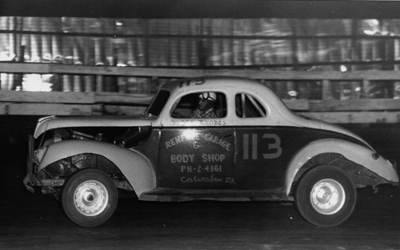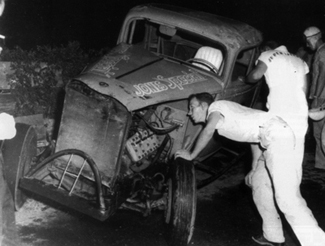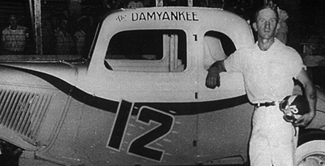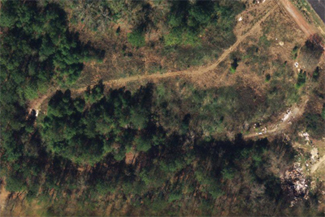
In the number 113 Ford Standard coupe from Columbus, Georgia is Dusty Rhodes – the perfect name for a race car driver. Taken at Columbus Super Speedway by Earl Garrettson.
By Mike Bell
Posted in Feature Stories 8/20/10
Most people don’t remember but there have been several race tracks in the Columbus, Georgia area that are long gone. Let’s quickly review the first two, which were the Idle Hour Speedway at Martin Stadium in Phoenix City, Alabama and the Columbus Speedway northeast of town off Hamilton Road.
Before World War II, the Peach State Midget Racing Association ran a single meet on the little track in Phoenix City at Idle Hour and shortly after the war, Alex Brewer of Tampa brought midget racing back to this facility. For about two and a half years, Columbus fans got to see the “Doodle Bugs” on the tiny track.
With the opening of Columbus Speedway in June of 1948, Idle Hour faded. Columbus Speedway was inspired by the success of the Jacksonville Speedway in Florida. The dusty half-mile, high-banked oval lasted only a few years. This was mainly due to a freak accident that saw one spectator lose a leg to amputation in the hospital and the death of seven-year-old James Brannon. Even though the first NASCAR championship was decided at the track in November of 1948, no PR could bring the crowds back.
For a few years, Columbus fans and racers had to sit at home or travel to Macon, Albany, LaGrange or Opelika, Alabama, to see racing. Then on April 24, 1953, promoter Carl Stevens opened something of a copy of the highly successful Peach Bowl in Atlanta. The Peach Bowl was more of an oval, whereas this new, almost flat quarter-mile track was shaped like a paper clip with real sharp turns and straights in-between.

Charlie Mincey sweeps under the checkered flag at Columbus Super Speedway, piloting Roy Shoemaker’s 1934 Ford 5-window coupe. Mincey won some 22 out of 25 features he entered for Shoemaker with this car.
The new track, originally called Rocket Speedway, opened to rave reviews and NASCAR Sportsman Division racing (like at the Peach Bowl). Early winners included the Myers Brothers of North Carolina, who went everywhere NASCAR held a sportsman race to garner points to win the National Championship Trophy.
But it soon diminished to locals trying to keep up with the Peach Bowl racers with a NASCAR Short Track Division late model race thrown in during the year. Lee Petty won the race in a 1953 Red Ram Dodge before a turn-away crowd. As the excitement of that race faded, the 1953 season closed down racing.
But in 1954, the track changed promoters as well as their class. They opened with the same top class as the Peach Bowl, but local racers were several years behind the Atlanta bunch and week-to-week, the locals couldn’t keep up. Atlanta weekly racing was highly competitive due to an early start some drivers had (1946 or 1947) and the six to eight years of knowledge in running the temperamental flathead Ford, the racing engine of that period.
Georgia Racing Hall of Fame member Charlie Mincey won five features in a row before the track switched to amateur only racing. The local drivers made a showing, but there just weren’t enough to keep the fans in the stands.
The next year, the restrictions flip-flopped during the season and local drivers made a showing by winning the first race, beating out-of-towner Nero Steptoe. Jack Ferguson was his name, but he was only stationed at Fort Benning.

This 1934 Ford coupe is the Jones Special of Harvey Jones, Sr. out of Tallahassee, Florida. Jones saw much success at Georgia tracks, and is a member of the Georgia Racing Hall of Fame.
A real local driver broke his winning streak two weeks later. It was O.H. Baker, the Flying Mayor of Crawford, Alabama. Baker outran the field the third week. Bo Spradlin then broke the Mayor’s winning streak. Between these drivers and Harvey Jones of Tallahassee, Florida, Walt Kruger, Gaines Hart and a transplanted Yankee, Eddie MacDonald, all features went mostly to a local group. Kruger won the season ending championship in late October.
The 1956 season saw either Harvey Jones or Eddie MacDonald win the races. The Flying Mayor was critically injured at the Auburn-Opelika oval and never made a comeback.
There was another NASCAR late model race after the Southern 500 that year, and Joe Eubanks of Spartanburg took it. At the end of the season, the strictly stock crowd took over the speedway again to slim crowds, cold weather and few cars.

Standing next to the number 12 is the Damn Yankee, Eddie MacDonald at Columbus Super Speedway. MacDonald was transferred to Fort Benning while in the service, and lie the South so much, he stayed.
Jack Ferguson, considered a local but actually from Raleigh, North Carolina, via the Army, won the two opening races at Super Speedway in 1957. Then Harvey Jones and Eddie MacDonald took over again, with Bo Spradlin and Walt Kruger winning as well. It went back and forth each week the way racing should be. Jones would win one week, with MacDonald the next week, the Spradlin the following week and Kruger the next. Jack Ferguson sneaked into victory lane as well.
It all boiled down to the last race of the year, which was held on Thanksgiving, November 28. It was the only race held in Georgia on that day.
Harvey Jones won the 50-lap feature to become the 1957 Georgia State Champion. Sam McQuagg, and up-and-coming driver from Columbus, was second, with the late J.C. Hendricks of Griffin, Georgia third, Charles Barnett of Orlando fourth, Wildman Jerry Smith of Chattanooga fifth and Willie Quattlebaum sixth.

A young Sam McQuagg carries the checkered flag on a victory lap. McQuagg was born, raised, played high school football, married, had children and raced out of Columbus, Georgia.
The MARC Southern Division became the ruling body over the Super Speedway in 1958. The rules would be the same there as well as other North Georgia tracks such as the Peach Bowl, Dallas, Canton, Hall County or Banks County.
And as a special added attraction, the late model division of the MARC Southern Division would make several appearances at Super Speedway during the year.
Roscoe Thompson won the first late model race before some 2,500 fans, and would do so again in July. Otherwise, it was the Harvey Jones and Eddie MacDonald show each week with Frank Taylor, Walt Kruger and Sam McQuagg winning one race apiece. McQuagg won the last race of the season in late October, even though the Southern Racing Enterprises promised more in November. However, no more racing was held there in 1958.

Today, the Columbus Super Speedway sits alone and mostly forgotten. Odds are the folks shopping at that shopping center directly in front of the old track haven’t got the first clue that a race track is so close to them.
The 1959 season at Super Speedway started late as Jimmy Thomas, a local furniture store owner, didn’t open the track until June 3, a Wednesday night, with modified racing. Nero Steptoe brought a car over from Birmingham and took the opener.
Roscoe Thompson, Freddie Fryer, Charlie Mincey and Ernie Reeves of Miami, Florida (with the initial invasion of the Allison brothers) won the races. Only local (but transplanted) Eddie MacDonald could break in the winners circle for the locals. MacDonald had a big win on Labor Day at the tiny oval with the Georgia State Championship, which essentially closed the track for good.
Willie Quattlebaum tried to reopen the track in 1960 with amateurs, but no one showed – neither fans nor racers. So Super Speedway at the corner of Victory Drive and Lumpkin Road went the way of all race tracks, as it became a shopping center.
But, when you drive by, you can still hear the modifieds. Or at least I can.
Editor’s note: This story was originally published in the March 2000 edition of the Pioneer Pages magazine.
Mike Bell is the CEO and historian for the Georgia Auto Racing Hall of Fame Association, Inc. (GARHOFA).
Questions, comments, suggestions? Email us!
This website is not affiliated with or endorsed by the Georgia Racing Hall of Fame or the Georgia Auto Racing Hall of Fame Association, Inc. All content is the intellectual property of the individual authors. All opinions are those of the individual authors. Please do not repost images or text without permission.
